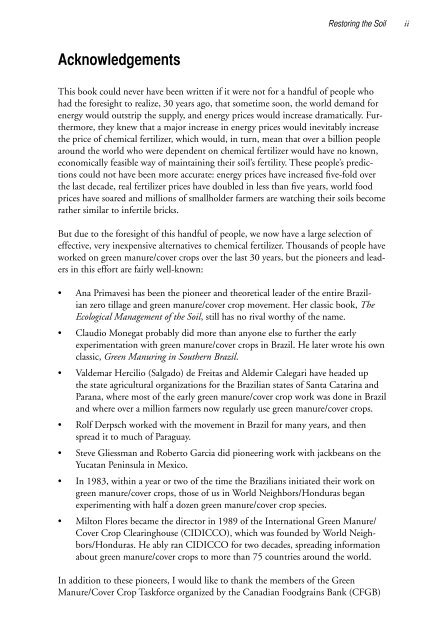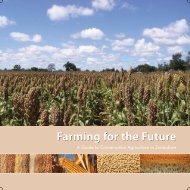Restoring the Soil - Canadian Foodgrains Bank
Restoring the Soil - Canadian Foodgrains Bank
Restoring the Soil - Canadian Foodgrains Bank
You also want an ePaper? Increase the reach of your titles
YUMPU automatically turns print PDFs into web optimized ePapers that Google loves.
<strong>Restoring</strong> <strong>the</strong> <strong>Soil</strong>iiAcknowledgementsThis book could never have been written if it were not for a handful of people whohad <strong>the</strong> foresight to realize, 30 years ago, that sometime soon, <strong>the</strong> world demand forenergy would outstrip <strong>the</strong> supply, and energy prices would increase dramatically. Fur<strong>the</strong>rmore,<strong>the</strong>y knew that a major increase in energy prices would inevitably increase<strong>the</strong> price of chemical fertilizer, which would, in turn, mean that over a billion peoplearound <strong>the</strong> world who were dependent on chemical fertilizer would have no known,economically feasible way of maintaining <strong>the</strong>ir soil’s fertility. These people’s predictionscould not have been more accurate: energy prices have increased five-fold over<strong>the</strong> last decade, real fertilizer prices have doubled in less than five years, world foodprices have soared and millions of smallholder farmers are watching <strong>the</strong>ir soils becomera<strong>the</strong>r similar to infertile bricks.But due to <strong>the</strong> foresight of this handful of people, we now have a large selection ofeffective, very inexpensive alternatives to chemical fertilizer. Thousands of people haveworked on green manure/cover crops over <strong>the</strong> last 30 years, but <strong>the</strong> pioneers and leadersin this effort are fairly well-known:• Ana Primavesi has been <strong>the</strong> pioneer and <strong>the</strong>oretical leader of <strong>the</strong> entire Brazilianzero tillage and green manure/cover crop movement. Her classic book, TheEcological Management of <strong>the</strong> <strong>Soil</strong>, still has no rival worthy of <strong>the</strong> name.• Claudio Monegat probably did more than anyone else to fur<strong>the</strong>r <strong>the</strong> earlyexperimentation with green manure/cover crops in Brazil. He later wrote his ownclassic, Green Manuring in Sou<strong>the</strong>rn Brazil.• Valdemar Hercilio (Salgado) de Freitas and Aldemir Calegari have headed up<strong>the</strong> state agricultural organizations for <strong>the</strong> Brazilian states of Santa Catarina andParana, where most of <strong>the</strong> early green manure/cover crop work was done in Braziland where over a million farmers now regularly use green manure/cover crops.• Rolf Derpsch worked with <strong>the</strong> movement in Brazil for many years, and <strong>the</strong>nspread it to much of Paraguay.• Steve Gliessman and Roberto Garcia did pioneering work with jackbeans on <strong>the</strong>Yucatan Peninsula in Mexico.• In 1983, within a year or two of <strong>the</strong> time <strong>the</strong> Brazilians initiated <strong>the</strong>ir work ongreen manure/cover crops, those of us in World Neighbors/Honduras beganexperimenting with half a dozen green manure/cover crop species.• Milton Flores became <strong>the</strong> director in 1989 of <strong>the</strong> International Green Manure/Cover Crop Clearinghouse (CIDICCO), which was founded by World Neighbors/Honduras.He ably ran CIDICCO for two decades, spreading informationabout green manure/cover crops to more than 75 countries around <strong>the</strong> world.In addition to <strong>the</strong>se pioneers, I would like to thank <strong>the</strong> members of <strong>the</strong> GreenManure/Cover Crop Taskforce organized by <strong>the</strong> <strong>Canadian</strong> <strong>Foodgrains</strong> <strong>Bank</strong> (CFGB)
















